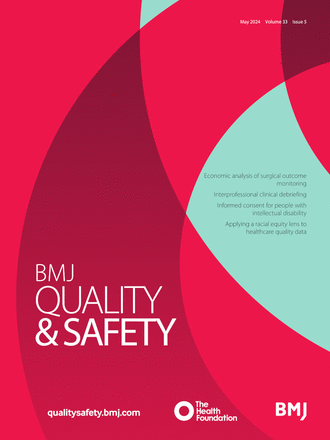Routine versus prompted clinical debriefing: aligning aims, mechanisms and implementation
IF 5.6
1区 医学
Q1 HEALTH CARE SCIENCES & SERVICES
引用次数: 0
Abstract
The great art of learning is to understand but little at a time. —John Locke Clinical debriefing (CD) is rapidly gaining traction as a valuable activity. CD is usually conducted as a guided exploration and reflection of clinical events in an attempt to bridge the gap between experience and understanding, with the ultimate aim of influencing future practice.1 CD has the potential to improve outcomes for staff, teams, patients and systems.2 3 The evidence for CD exists and continues to grow; benefits range from changes in staff attitudes4 to favourable outcomes following cardiac arrest.5 Despite this, some clinicians have been sceptical about the impact of CD, and there are various barriers which may limit implementation. These include lack of clear purpose, actual or perceived lack of time, lack of experienced debriefers and cultural resistance to change.6 Our focus should now be shifting towards overcoming barriers to implementation, a disappointingly difficult feat.7 8 The paper by Paxino et al 9 in this issue of BMJ Quality & Safety responds to this call and suggests that a lack of standardised terminology to describe CD practices may be part of the implementation problem. Paxino et al use scoping review methodology to explore how contextual factors relating to interdisciplinary CD are described in the existing literature, and whether these can be used to differentiate approaches to CD. They explore 46 studies using the ‘Who–What–When–Where–Why–How’ framework, with particular emphasis on contextual factors related to the ‘What’ and ‘When’ elements to differentiate between CD approaches. Based on their findings, they reconceptualise the terminology of CD practices into ‘prompted’ (further differentiated into ‘immediate’ and ‘delayed’) and ‘routine’ (further differentiated into ‘postoperative’ and ‘end of shift’), and propose a move away from a one-size-fits-all way of describing CD practices. They argue that …常规临床汇报与提示性临床汇报:目标、机制与实施的统一
学习的伟大艺术在于每次只懂一点。-临床汇报(CD)作为一种有价值的活动正迅速受到重视。临床汇报通常是在指导下对临床事件进行探讨和反思,试图弥合经验与理解之间的差距,最终目的是影响未来的实践。1 临床汇报有可能改善员工、团队、患者和系统的成果。2 3 临床汇报的证据已经存在并在不断增加;其益处包括员工态度的转变4 以及心脏骤停后的有利结果5。这些障碍包括缺乏明确的目的、实际或感知到的时间不足、缺乏有经验的汇报者以及文化上对变革的抵触。6 我们现在应该将重点转移到克服实施障碍上,但这是一项令人失望的艰巨任务。7 8 本期《英国医学杂志质量与安全》(BMJ Quality & Safety)中 Paxino 等人9 的论文响应了这一呼吁,并提出缺乏描述 CD 实践的标准化术语可能是实施问题的一部分。Paxino 等人采用范围综述方法探讨了现有文献中如何描述与跨学科 CD 相关的背景因素,以及这些因素是否可用于区分 CD 方法。他们使用 "谁-什么-何时-何地-为何-如何 "框架探讨了 46 项研究,特别强调了与 "什么 "和 "何时 "要素相关的背景因素,以区分不同的 CD 方法。根据研究结果,他们重新定义了 CD 实践的术语,将其分为 "提示"(进一步区分为 "即时 "和 "延迟")和 "常规"(进一步区分为 "术后 "和 "轮班结束"),并建议摒弃一刀切的 CD 实践描述方式。他们认为...
本文章由计算机程序翻译,如有差异,请以英文原文为准。
求助全文
约1分钟内获得全文
求助全文
来源期刊

BMJ Quality & Safety
HEALTH CARE SCIENCES & SERVICES-
CiteScore
9.80
自引率
7.40%
发文量
104
审稿时长
4-8 weeks
期刊介绍:
BMJ Quality & Safety (previously Quality & Safety in Health Care) is an international peer review publication providing research, opinions, debates and reviews for academics, clinicians and healthcare managers focused on the quality and safety of health care and the science of improvement.
The journal receives approximately 1000 manuscripts a year and has an acceptance rate for original research of 12%. Time from submission to first decision averages 22 days and accepted articles are typically published online within 20 days. Its current impact factor is 3.281.
文献相关原料
| 公司名称 | 产品信息 | 采购帮参考价格 |
|---|
 求助内容:
求助内容: 应助结果提醒方式:
应助结果提醒方式:


